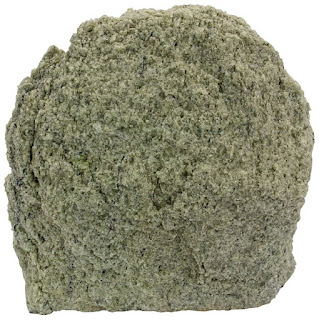What is dunite?
Dunite (otherwise called olivinite, not to be mistaken for the mineral olivenite) is a volcanic, plutonic shake, of ultramafic arrangement, with coarse-grained or phaneritic surface. The mineral collection is more noteworthy than 90% olivine, with minor measures of different minerals, for example, pyroxene, chromite, magnetite, and pyrope. Dunite is the olivine-rich end-individual from the peridotite gathering of mantle-inferred rocks. Dunite and other peridotite rocks are viewed as the real constituents of the Earth's mantle over a profundity of around 400 kilometres. Dunite is once in a while found inside mainland rocks, however where it is discovered, it commonly happens at the base of ophiolite successions where pieces of mantle shake from a subduction zone have been pushed onto mainland outside layer by obduction amid mainland or island circular segment crashes (orogeny). It is likewise found in high peridotite massifs that speak to bits of sub-mainland mantle uncovered amid collisional orogeny. Dunite commonly experiences retrograde transformative nature in close surface situations and is modified to serpentinite and soapstone. Dunite is an igneous intusive rock which is a coarsed grained, greenish colour. It is composed of mineral olivine up to 90 percent. Some dunites are rich in chromite, magnetite, ilmenite or pyrrhotite and can also have small amount of pyroxene. Dunite occurs in layered gabbroic complexes. It probably forms from the accumulation of dense, early crystallizing grains of olivine that sink to the bottom of low silica magma. Intrusions of dunite form sills or dikes. Some dunite has been altered to form serpentine. Dunite is named after Dun mountain in New Zealand.
Dunite association
The sort of dunite found in the lowermost parts of ophiolites, high peridotite massifs, and xenoliths may speak to the stubborn buildup left after the extraction of basaltic magmas in the upper mantle. Be that as it may, a more probable technique for dunite arrangement in mantle areas is by collaboration between lherzolite or harzburgite and permeating silicate liquefies, which break down orthopyroxene from the encompassing rock, leaving a logically olivine-improved buildup. Dunite may likewise frame by the amassing of olivine gems on the floor of substantial basaltic or picritic magma chambers. These "cumulate" dunites commonly happen in thick layers in layered interruptions, connected with cumulate layers of wehrlite, olivine pyroxenite, harzburgite, and even chromitite (a cumulate shake comprising to a great extent of chromite). Little layered interruptions might be of any geologic age, for instance, the Triassic Palisades Sill in New York and the bigger Eocene Skaergaard complex in Greenland. The biggest layered mafic interruptions are several kilometers in size and all are Proterozoic in age, e.g., the Stillwater molten complex (Montana), the Muskox interruption (Canada), and the Great Dyke (Zimbabwe). Cumulate dunite may likewise be found in ophiolite edifices, connected with layers of wehrlite, pyroxenite, and gabbro.
History of Dunite
Dunite was named by the German geologist, Ferdinand von Hochstetter in 1859 after Dun Mountain close Nelson, New Zealand. Dun Mountain was given its name on account of the dun shade of the basic ultramafic rocks. This shading comes about because of surface weathering that oxidises the iron in olivine in mild atmospheres (weathering in tropical atmospheres makes a dark red soil). Dun Mountain is isolated from its sister massif, Red Mountain, at the southern end of South Island, New Zealand, by the Alpine Fault, a roughly 600 km long right horizontal strike slip blame like the San Andreas blame in California, USA. A monstrous presentation of dunite in the United States can be found as Twin Sisters Mountain, close Mount Baker in the northern Cascade Range of Washington. In southern British Columbia, Canada dunite rocks shape the centre of a ultramafic shake complex situated close to the little group of Tulameen. The stones are privately advanced in platinum assemble metals, chromite and magnetite.













ليست هناك تعليقات:
Write التعليقات